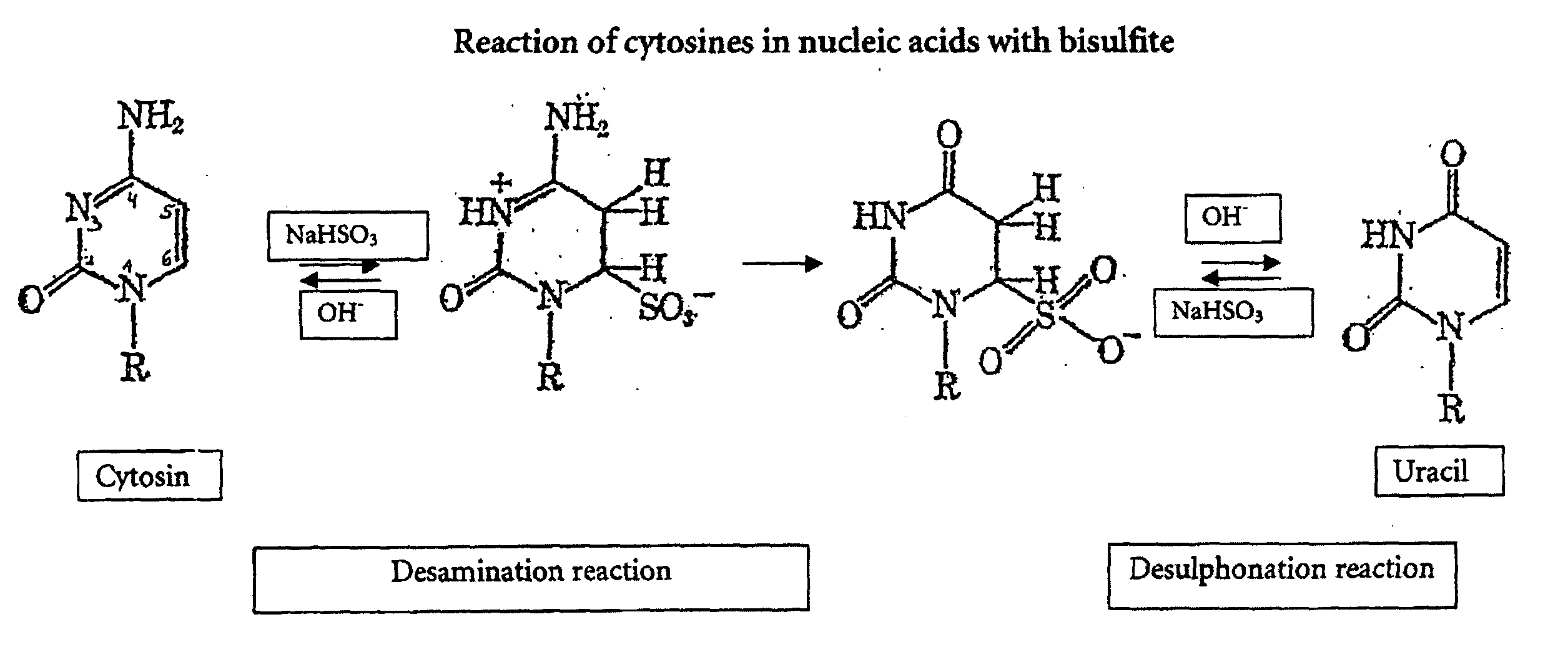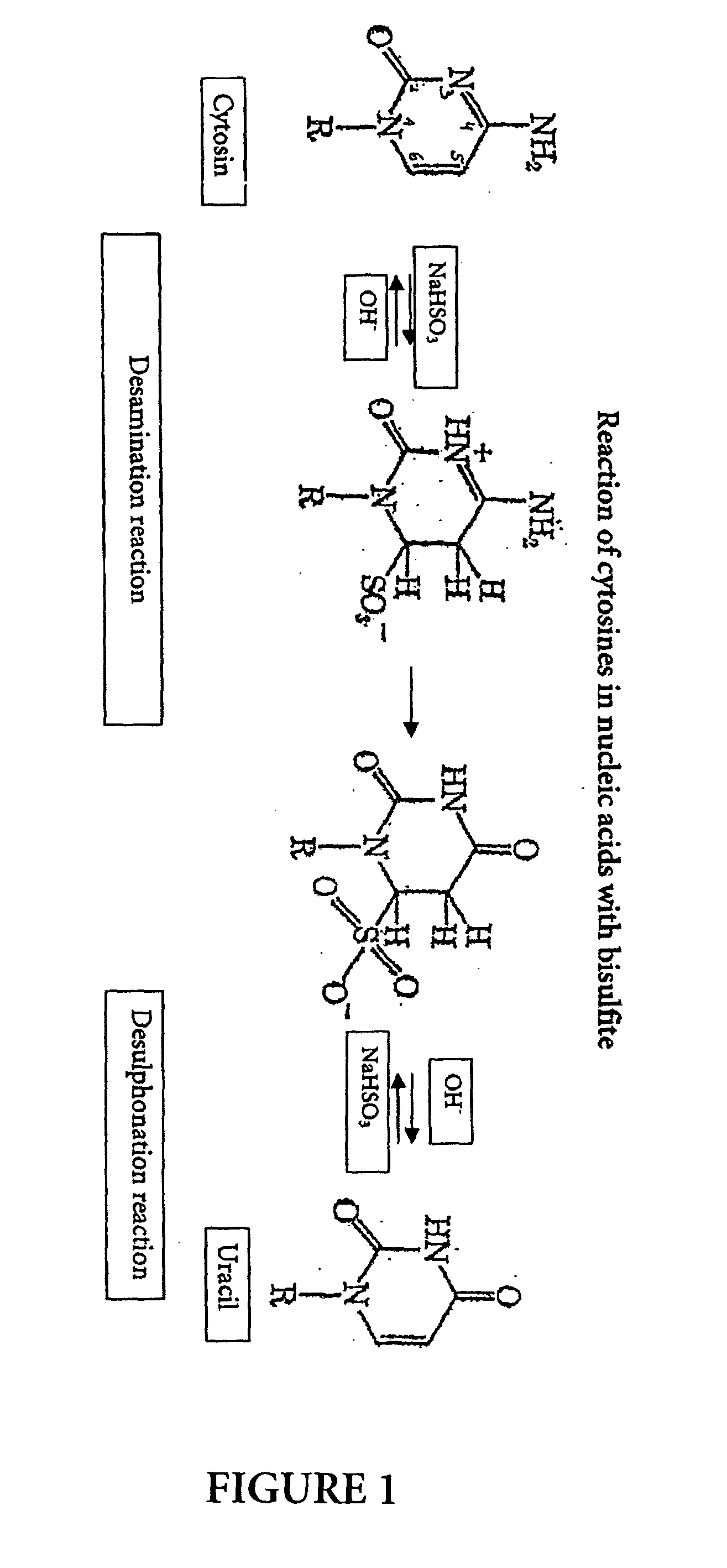Method for bisulfite treatment
- Summary
- Abstract
- Description
- Claims
- Application Information
AI Technical Summary
Benefits of technology
Problems solved by technology
Method used
Image
Examples
example 1
1. Example 1
Establishment of a LC-PCR Specific for Bisulphite Treated DNA
[0085] 1.1 General
[0086] The fact that the bisulfite reaction has worked and converted non-methylated cytosines to uracil can be demonstrated by a polymerase chain reaction whereby primers are used which are specific to a region of the nucleic acid sequence wherein non-methylated cytosines have been converted to uracils, i.e. the base adenine in the primer is opposite to the uracil being the bisulfite reaction product from non-methylated cytosines. In case of incomplete conversion, the primer could not hybridize to this region as there would be cytosines not matching the adenine bases in the primer. This would have the effect that no PCR product would be obtained.
[0087] An improved method to perform rapid polymerase chain reactions is disclosed e.g. in U.S. Pat. No. 6,174,670 and is used in the LightCycler.RTM. instrument (Roche, Mannheim, Germany). In this method, two labeled probes can come into close proximi...
example 2
2. Example 2
Bisulfite Reaction Using Magnetic Glass Particles (MGPs)
[0096] 2.1.1 Denaturation of DNA:
[0097] 100 .mu.l of methylated DNA (Intergen, distributed by Serologicals Corporation, Norcross, Ga., USA; Cat S 7821) dilution (30 ng and 6 ng / assay spiked in 1000 ng hDNA background Roche Cat.1691112; 10 replicates per concentration), and 12 .mu.l 2 M NaOH are mixed and incubated for 15 min at 37.degree. C.
[0098] 2.1.2 Deamination of DNA
[0099] 112 .mu.l of the denatured DNA are mixed with 200 .mu.l bisulfite reagent (2.5M sodium disulfite, 125 mM hydroquinone, pH 5.0) and incubated for 16 h at 50.degree. C.
[0100] 2.2 Processing using MGPs
[0101] 312 .mu.l of the deaminated DNA are mixed with 600 .mu.l binding buffer (MagNAPure DNA Isolation Kit I, Roche Cat. Nr. 3 003 990) and 75 .mu.l magnetic glass particle solution (MagNAPure DNA Isolation Kit I) and incubated for 15 min / room temperature with continuous mixing. Thereafter, the magnetic glass particles are washed three times with ...
example 3
3 Example 3
Automated Bisulphite Reaction Using MGPs
[0115] 3.1 Performance of Bisulphite Reaction
[0116] 3.1.1 Denaturation of DNA:
[0117] 20 .mu.l of methylated DNA (Intergen, distributed by Serologicals Corporation, Norcross, Ga., USA; Cat.S7821) dilution (50 ng / assay), 4 .mu.l of a Poly (dA) solution (concentration 250 ng / .mu.l) and 2.6 .mu.l 2 M NaOH are mixed and incubated for 10 min at
[0118] 3.1.2 Deamination of DNA
[0119] 26 .mu.l of the denatured DNA are mixed with 220 VI bisulfite reagent (2.5M Sodium bisulfite, 125 mM hydroquinone, pH 5.0) and incubated for 4 h at 50.degree. C.
[0120] 3.1.3 Automated Processing Using the MagnaPure LC-Instrument
[0121] 250 .mu.l of the deaminated DNA are mixed with 600 .mu.l binding buffer (MagNAPure DNA Isolation Kit I, Roche, Mannheim, Germany) and 75 .mu.l magnetic glass particle solution (MagNAPure DNA Isolation Kit I, Roche, Mannheim, Germany) and incubated for 15 min / room temperature with continuous mixing. Thereafter, the magnetic glass pa...
PUM
| Property | Measurement | Unit |
|---|---|---|
| Diameter | aaaaa | aaaaa |
| Diameter | aaaaa | aaaaa |
| Diameter | aaaaa | aaaaa |
Abstract
Description
Claims
Application Information
 Login to View More
Login to View More - R&D
- Intellectual Property
- Life Sciences
- Materials
- Tech Scout
- Unparalleled Data Quality
- Higher Quality Content
- 60% Fewer Hallucinations
Browse by: Latest US Patents, China's latest patents, Technical Efficacy Thesaurus, Application Domain, Technology Topic, Popular Technical Reports.
© 2025 PatSnap. All rights reserved.Legal|Privacy policy|Modern Slavery Act Transparency Statement|Sitemap|About US| Contact US: help@patsnap.com


